Will the Biden Administration Investigate Evidence of Ghostwriting Involving Francis Collins and Anthony Fauci?
In a 2011 letter, Collins charged that failure to disclose author’s involvement is ghostwriting or plagiarism to be handled by the Office of Research Integrity which investigates research misconduct.
9 minute read
Did Drs. Francis Collins and Anthony Fauci commit research misconduct?
A recent batch of internal NIH emails suggests they did by providing “advice and leadership” on a widely cited paper that did not acknowledge their involvement and dismissed a possible virus research lab accident in China. The issue? Hiding an author’s contribution to a paper is ghostwriting or plagiarism to be handled by the Department of Health and Human Services Office of Research Integrity (ORI), according to a 2011 letter signed by Collins, while Director of the NIH.
Following a 2010 report about multiple NIH-funded scientists who were caught publishing papers ghostwritten for them, Collins wrote the letter to confirm that the NIH does not condone the practice of scientists taking another person’s ideas without providing credit. “For example, a case of ghostwriting involving NIH-funded researchers may be appropriate for consideration as a case of plagiarism; i.e. the appropriation of another person’s idea, processes, results, or words without giving appropriate credit,” wrote Collins.
According to Collins’ definition of ghostwriting, emails point to undisclosed input by Collins and Fauci into a widely cited 2020 paper in Nature Medicine called “Proximal Origins.” This paper sought to dismiss the possibility of a lab accident in China for starting the pandemic.
“We do not believe that any type of laboratory-based scenario is plausible,” the paper’s authors concluded.
According to newly unredacted emails, after Collins and Fauci reviewed multiple drafts of the paper over several weeks, the study’s lead author then thanked the two for their “advice and leadership” on the paper before publishing the piece in Nature Medicine without noting their participation. After helping with the manuscript, both Collins and Fauci then cited the paper as proof of a natural origin for COVID-19—Collins in a post on the NIH Director’s blog, and Fauci during a White House pandemic briefing with President Donald Trump.
Last week, I sent copies of these unredacted emails, as well a link to Collin’s 2011 letter, and asked HHS and NIH a series of questions about how they handle evidence of ghostwriting and plagiarism as defined by Collins. Both HHS, NIH have refused to respond.
Advice and leadership
Last summer, NIH emails became public through a Freedom of Information request showing that the NIH’s Anthony Fauci held a secret teleconference on Feb. 1, 2020, with an international group of scientists to discuss whether the COVID-19 virus looked like it might have been engineered in a laboratory. “We decided on the call the situation really needed to be looked into carefully,” Fauci told USA Today.
Others on the call included then NIH Director Francis Collins, the Wellcome Trust’s Jeremy Farrar, and several virologists who would go on to publish the “Proximal Origins” paper in Nature Medicine, including Kristian Andersen and Edward Holmes.
“What the email shows, is a clear example of the scientific process,” Andersen tweeted last summer, when one document became public.
The latest set of emails show that Andersen’s scientific process included sharing a draft of the paper with Farrar, Fauci, and Collins before even submitting it to the journal. On Feb. 4, 2020, Jeremy Farrar forwarded a draft of the paper, emailed to him by Edward “Eddie” Holmes.
“Please treat in confidence—a very rough first draft from Eddie and team—they will send on the edited, cleaner version later,” Farrar emailed Fauci and Collins. The following day, Farrar emailed Fauci and Collins, “Tony and Francis, The revised draft from Eddie, copied here.”
Along with the revised draft, Farrar sent Fauci and Collins the authors’ answers to questions that he had asked them about their paper.
On March 6, 2020, Andersen emailed Farrar, Fauci and Collins, asking for comments and suggestions for the paper:
Dear Jeremy, Tony, and Francis,
Thank you again for your advice and leadership as we have been working through the SARS-CoV-2 ‘origins’ paper. We’re happy to say that the paper was just accepted by Nature Medicine and should be published shortly (not quite sure when).
To keep you in the loop, I just wanted to share the accepted version with you, as well as a draft press release. We’re still waiting for proofs, so please let me know if you have any comments, suggestions, or questions about the paper or the press release.
Copying the other authors of the paper, Fauci replied, “Thanks for the note. Nice job on the paper.”
A week later, Nature Medicine published the origins paper on March 17. In the paper’s acknowledgements sections, the authors thanked a “M. Farzan for discussions” but did not note their discussions with Farrar, Fauci and Collins.
A week after Nature Medicine published the paper, Collins wrote a post for the NIH Director’s blog titled “Genomic Study Points to Natural Origin of COVID-19”:
The reassuring findings are the result of genomic analyses conducted by an international research team, partly supported by NIH. In their study in the journal Nature Medicine, Kristian Andersen, Scripps Research Institute, La Jolla, CA; Robert Garry, Tulane University School of Medicine, New Orleans; and their colleagues used sophisticated bioinformatic tools to compare publicly available genomic data from several coronaviruses, including the new one that causes COVID-19.
In his NIH Director’s blog, Collins makes no mention of that the paper’s lead author thanked him for advice and leadership on study. Collins ends the piece, claiming:
Either way, this study leaves little room to refute a natural origin for COVID-19 …
Finally, next time you come across something about COVID-19 online that disturbs or puzzles you, I suggest going to FEMA’s new Coronavirus Rumor Control web site. It may not have all the answers to your questions, but it’s definitely a step in the right direction in helping to distinguish rumors from facts.
A few weeks later, on April 17, the White House held a coronavirus briefing. While President Trump was at the podium, a reporter in the gallery requested Fauci to explain if the virus could have come from a Chinese laboratory. When the President moved aside, Fauci stepped to dais and cited the Nature Medicine piece, without mentioning the advice and leadership he had provided the authors.
Below is the official White House transcript of that briefing.
Q Mr. President, I wanted to ask Dr. Fauci: Could you address these suggestions or concerns that this virus was somehow manmade, possibly came out of a laboratory in China?
THE PRESIDENT: Want to go?
Q You studied this virus. What are the prospects of that?
DR. FAUCI: There was a study recently that we can make available to you, where a group of highly qualified evolutionary virologists looked at the sequences there and the sequences in bats as they evolve. And the mutations that it took to get to the point where it is now is totally consistent with a jump of a species from an animal to a human.
So, I mean, the paper will be available — I don’t have the authors right now, but we can make that available to you.
When questions arose early this year about the possible involvement of people not credited in the paper, Andersen tweeted that nobody who contributed to the paper went uncredited. “The people who wrote and contributed to the paper are authors on the paper—that’s how scientific publishing works.”
Francis Collins on scientists plagiarizing ideas
In 2011, I gathered documents released in a pharmaceutical lawsuit that showed several NIH-funded scientists had been provided ghostwritten papers that they later published without proper attribution. At the time, I was working at a Democratic party aligned nonprofit called the Project on Government Oversight.
After reviewing the court documents, I wrote a letter to Director Francis Collins detailing my findings. The ghostwriting documents and my letter to Collins were then covered by The New York Times and in a Nature editorial (Give up the Ghosts: Funding agencies should make researchers reveal industry links).
Responding in a letter addressed to me, Collins wrote that the NIH “does not condone the practice of ghostwriting” which is banned at the NIH. If federal funds are involved in a ghostwriting incident, Collins stated that the case could be handled by the Office of Research Integrity for to investigate as “a case of plagiarism.”
For example, a case of ghostwriting involving NIH-funded researchers may be appropriate for consideration as a case of plagiarism; i.e. the appropriation of another person’s ideas, processes, results or words without giving appropriate credit.
Failing to comply with Nature’s financial interests policy
The authors state in the paper that they are funded by the NIH and Farrar’s Wellcome Trust, but fail to disclose the “advice and leadership” provided by Farrar, Fauci and Collins. The authors also fail to disclose that they provided these funders with drafts of the paper and a right to comment and give suggestions, as offered in the March 6 email by lead author Kristian Andersen.
According to Nature’s policy, “A specific role for the funder in the conceptualization, design, data collection, analysis, decision to publish, or preparation of the manuscript, should be disclosed.” But in the competing interests declaration, the scientists only note that author Robert F. Garry “is co-founder of Zalgen Labs, a biotechnology company that develops countermeasures to emerging viruses.”
“The responsibility for reflecting substantive contributions to manuscripts through authorship lists lies with the authors themselves and we have received no communications from any researchers suggesting that their contributions have not been appropriately recognized,” said Dr Joao Monteiro, Chief Editor of Nature Medicine.
According to this Alice in Wonderland explanation, there might be nothing wrong if drug company executives secretly ghostwrite a study for Nature Medicine, unless the drug company executives then—for some bizarre reason—contact Nature “suggesting that their contributions have not been appropriately recognized.”
Dr. Monteiro also ignored questions about the authors’ failure to comply with Nature’s competing interest policy and disclose the involvement of funders Farrar, Collins and Fauci.
Breaking my decade old agreement with Collins
I want to clarify one point about the letter that Collins wrote to me back in 2011, explaining his position on ghostwriting. Collins didn’t write this letter only because he felt pressure from the New York Times and Nature. I was also backchanneling to him, because I knew that he had been involved in a ghostwritten paper published in Science.
When I first joined the Senate in 2007, one of my first jobs was investigating David Schwartz, who ran the NIH’s National Institute of Environmental Health Sciences (NIEHS). I spent several months that year investigating Schwartz, uncovering a variety of ethical lapses that were covered by the Washington Post, Science, New York Times, Nature, and other outlets.
While investigating Schwartz, I learned from my sources that one of Schwartz’s employees wrote a paper that Schwartz then gave to Collins, and which they then published together in Science, without mention of the original author. Sources told me that this crushed the young woman at the NIEHS as she expected to be an author with Schwartz and Collins on an important policy paper in the prestigious journal. She was incensed, several sources told me, and threatened to report the matter, but she was also afraid of damaging her career by speaking out against senior scientists.
At the time I learned this in 2007, I did not know what to do. In my experience, it is common for senior scientists—often men—to steal from junior researchers, especially when they are women. I also knew that she was frightened, and I was worried that I would not be able to protect her. Outing her might only make her life worse.
But a few years later, I helped to write a Senate report on ghostwriting in biomedicine and realized how common and damaging to public health this practice is. After we released the report, I met for coffee with the NIH congressional affairs person and demanded that Collins do something about ghostwriting. Ghostwriting was unethical and dangerous for public health, I pointed out. While Collins didn’t realize this, he had put his name on a paper that had been ghostwritten for him by an NIEHS employee who was not given credit for her work.
Collins needed to act.
Shortly after, I left my job in Congress to work at the Project on Government Oversight. When I uncovered the court documents showing ghostwriting that involved NIH-funded scientists, I wrote a letter to Collins detailing what I had found in the documents.
I then called the NIH congressional affairs employee and reminded him of our talk over coffee and what I knew about the Science paper with Collins’ name on it. If Collins ignored my letter, if he ignored this problem with ghostwriting, I was going public about that paper in Science and how it had been ghostwritten by a low-ranking woman at the NIEHS.
When Collins wrote me back, I kept my end of the agreement and remained silent.
But after reading Collins’ undisclosed “advice and leadership” on this 2020 piece in Nature Medicine—which feels awfully similar to Collins’ own definition of ghostwriting—I feel that Collins has broken our agreement from a decade ago.
I now feel free to report what happened with this paper that Collins published in Science. Besides, NIH has done nothing to fix the problem and give deserved credit to the woman who first drafted the paper. (Don’t hold your breath and expect the editors at Science to do anything. That’s not how science at Science works! )
The 2020 Nature Medicine paper represents the third incident of NIH-funded virologists orchestrating a publication in early 2020 to shoot down the possibility that a lab accident may have started the pandemic. As I previously reported in The BMJ, Peter Daszak secretly arranged a letter in the Lancet that labeled a possible Wuhan lab accident a “conspiracy theory.” Daszak runs the NIH-funded nonprofit EcoHealth Alliance and The Lancet letter did not disclose that he has funded research at the Wuhan Institute of Virology.
Other NIH-funded researchers placed an essay in the journal Emerging Microbes & Infections, that also called it a “conspiracy theory” to claim that the COVID-19 pandemic could have started from a Wuhan lab accident. Emails made public show that the authors secretly provided the draft for approval to a virologist at the Wuhan Institute of Virology and then hid her participation.
This paper also seems to represent an example of ghostwriting or plagiarism, to be handled by the Office of Research Integrity, as explained by Collins in his 2011 letter.
Don’t we all deserve better?
Next week, I’ll be discussing a hidden intelligence report that shows virologists used their Nature Medicine paper to mislead The U.S. Intelligence Community.

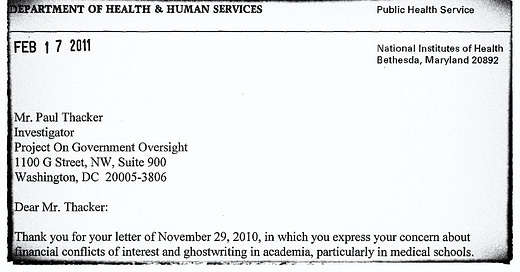



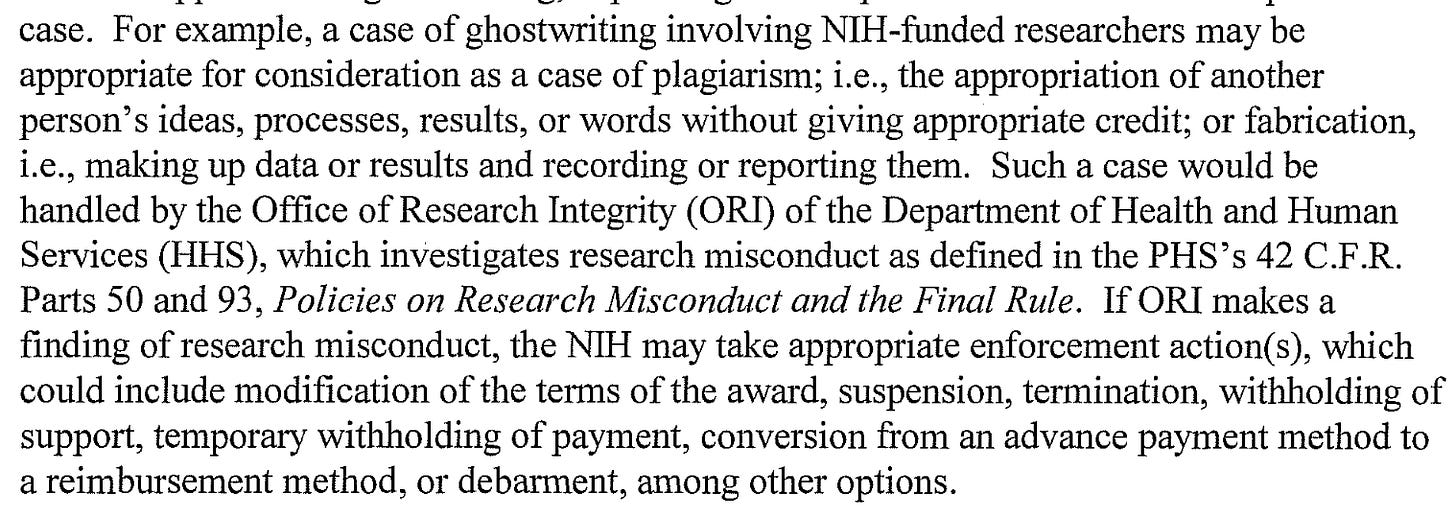
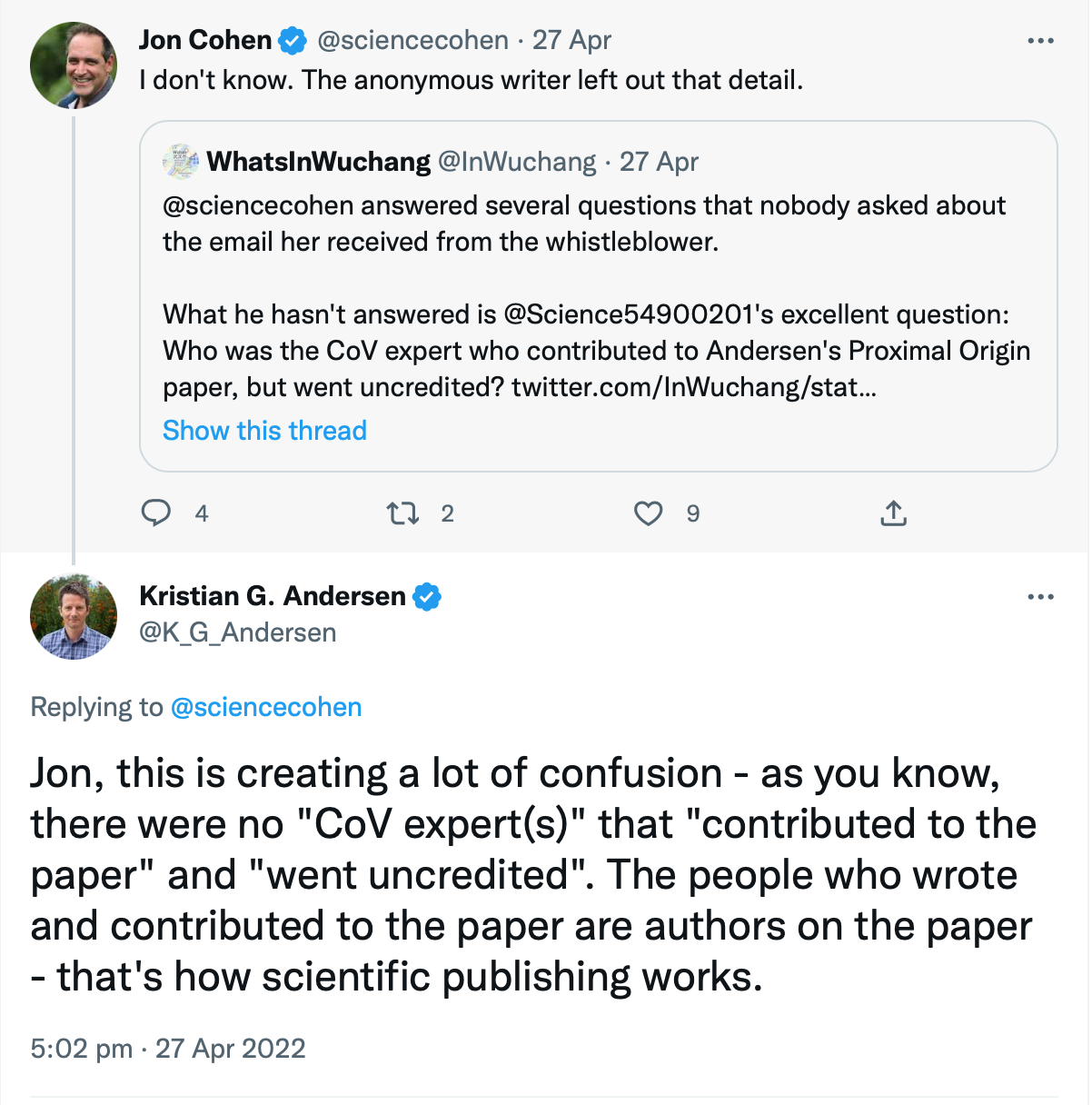
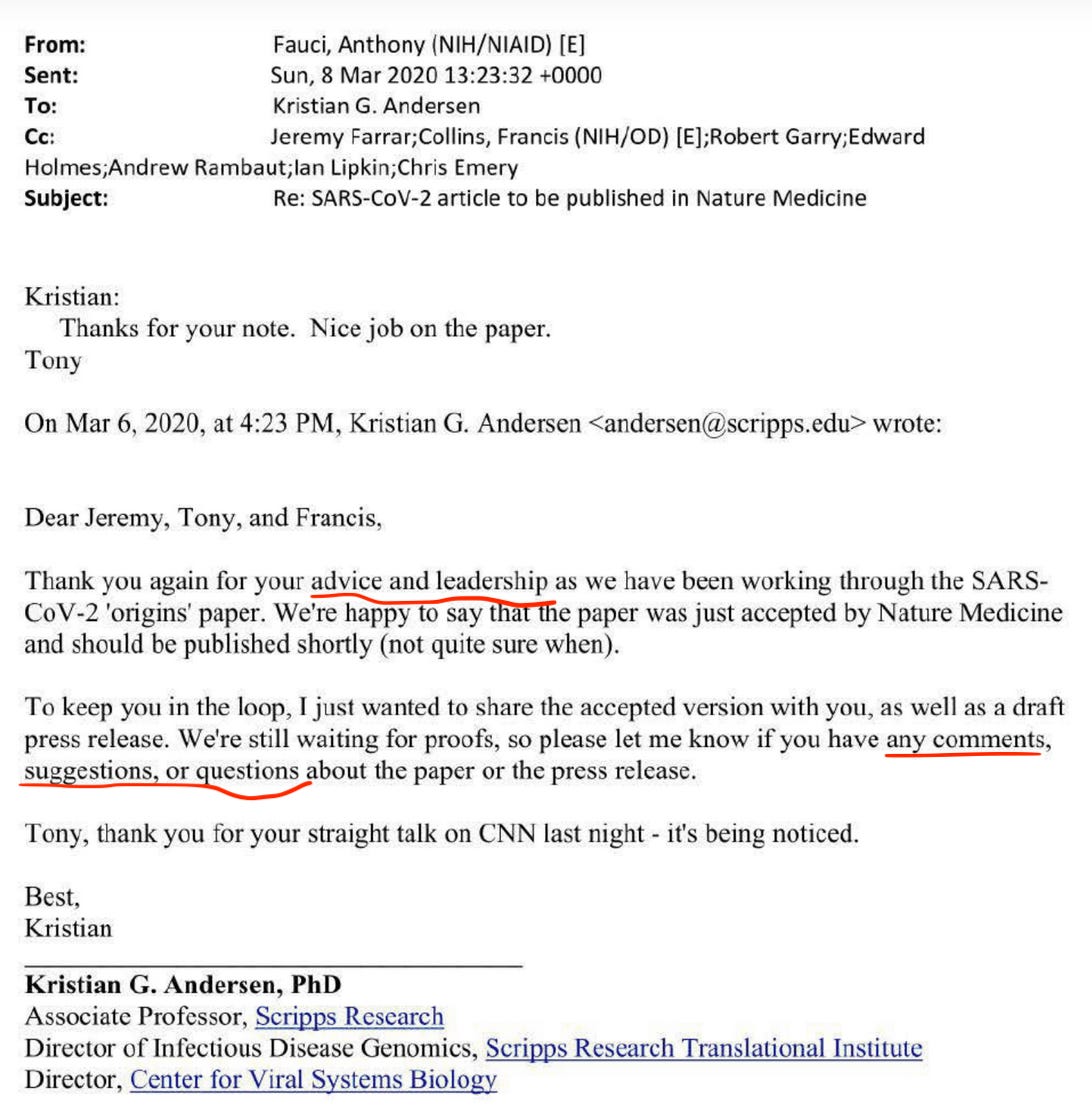
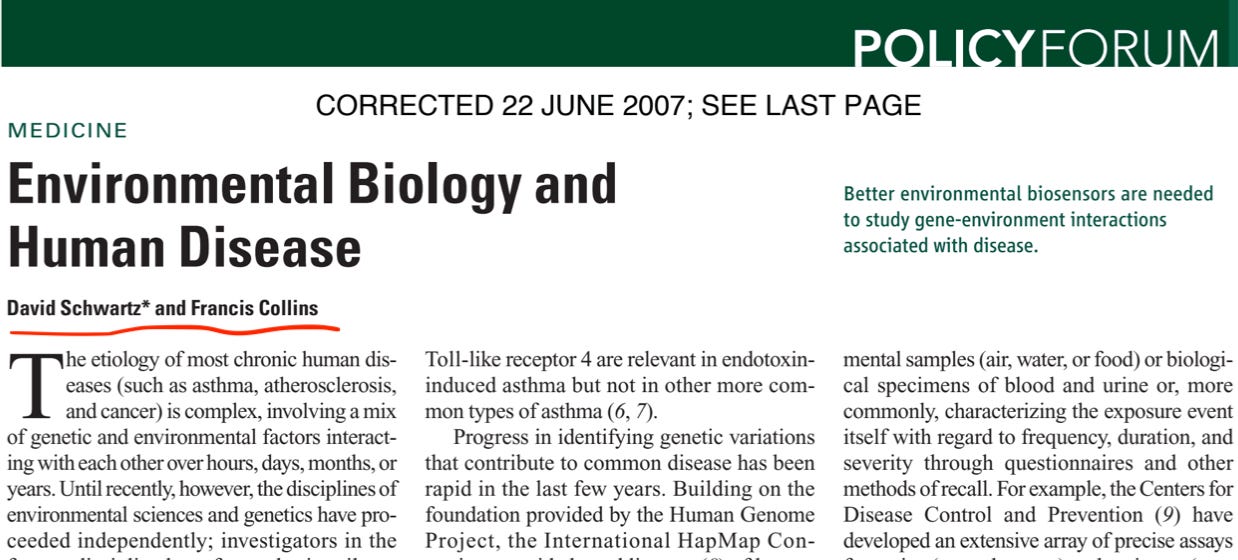


Behind the black veil of today’s scientific integrity, much fuckery abounds. May your bright beams of sunshine banish those pulling the levers.
Thank you Mr Thacker for revealing this information. It is appreciated. Perhaps your experience with a “broken” agreement will be a sign of caution for those considering similar arrangements currently.